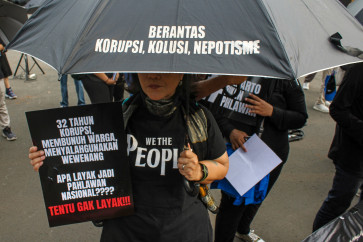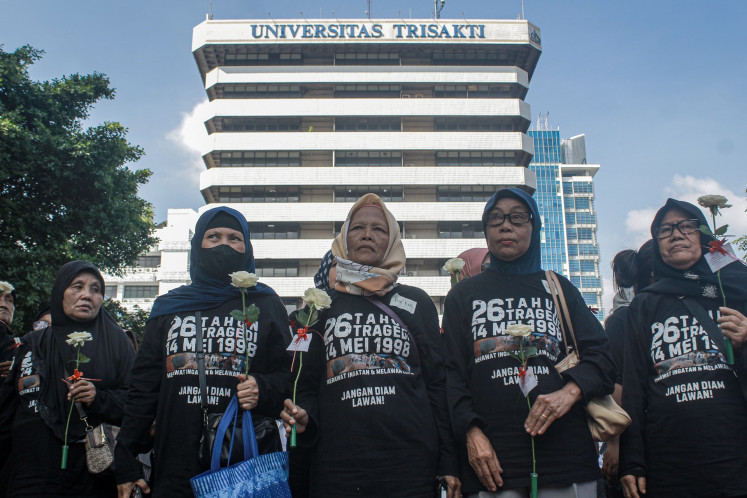Dangerous parallels between Bibit-Chandra and Bank Century
The first BC case (Bibit-Chandra) has reached the beginning of the end, while the second BC (Bank Century) case is at the end of the beginning
Change text size
Gift Premium Articles
to Anyone

T
he first BC case (Bibit-Chandra) has reached the beginning of the end, while the second BC (Bank Century) case is at the end of the beginning. There are dangerous parallels between the two BC cases.
In both cases, legitimate concerns about the public interest have sparked popular opinion. Public opinion is flexing its muscles with the effective use of social media on the internet. Facebook and blogs and instant messaging tools have given people access to the public debate on a scale never before experienced.
State-of-the-art television coverage presents serious issues as reality shows that arouse emotions exceeding understanding of the technicalities. Television and internet media help to educate and empower the public and present the parallels between the two cases. But there are important differences.
The Bibit-Chandra case is largely about moral issues: sincerity and duty versus greed and conspiracy. The Bank Century case is not that simple. It is very technical, involving banking and economic crisis management. Yet the momentum of public euphoria is carrying energy from the Bibit-Chandra case to the Bank Century case. Following the 1.4 million Facebook votes in support of Bibit-Chandra, there is a motion of no confidence against the President. While it is too serious, it would be dangerous to ignore the parallel.
People power is good, but not if it is driven by the greed of politicians and big money from business people who need to secure their privileges. The SBY coalition is broad but not deep. Many ostensible SBY supporters stand to gain from the removal of the two finance icons, even at the risk of destabilizing the government.
The Bibit-Chandra case is at the beginning at the end. The President's November 16 speech put forth mixed signals, but it was actually a clear message. It was presidential in language but poor in timing, too little too late. It is a do-it-yourself solution which demands follow up action from the Police Chief and the Attorney General. The Cabinet has formed a task force to clean up the justice system. The public is invited to be more confident in demanding broad reforms.
The Bank Century case is at the end of the beginning, an issue which lay dormant for a year until the political landscape changed. Bank Century fell because of fraud perpetrated by its owners and their cronies who bled its treasury to death. The government has dealt with this part of the crisis by prosecuting the criminals, recovering the stolen money and taking control of the bank. The final act was to choose whether to let Bank Century disappear or to salvage its carcass.
Imagine a house run by owners living a life of lust and sin. Suddenly they went wild, removed the valuables and left the house burning. Authorities had to move fast and decide what to do with the house. They could let it burn to ashes, or they could put out the fire and rescue the house. Had the house stood alone on empty land, it could be left to burn. But the house is in a densely populated area. The fire could easily spread to houses next door to eventually burn out the whole area. Fire spreads easily in some conditions, and this was an extremely volatile time.
At the height of the economic crisis in November 2008, the Indonesian treasury faced a dilemma. If they let Bank Century fold, a domino effect could threaten to hurl other financial institutions into bankruptcy and trigger a crisis of confidence in the market.
Hank Paulson, the US treasury secretary at the time, faced the same dilemma and chose to let Lehman Brothers fall. That was followed by a deluge of financial failures which left the US economy reeling, sending an urgent message to the rest of the world. Neighboring countries like Singapore, Malaysia, and Australia immediately imposed a blanket guarantee on their banks.
Indonesian businessmen implored our government to do the same, but the cost would be prohibitive. Instead, Indonesia chose to rescue banks deemed to pose systemic risk to the banking system. Bank Century was brought to the Committee for Stabilization of the Financial Sector (KSSK) which decreed a takeover, entrusting it to the Deposit Insurance Agency (LPS). Depositors' money was safeguarded as Rp 4.3 trillion in deposits were rescued from the bank. This scene belonged to the Finance Ministry, center stage but brief. The drama then followed.
Politicians and business people who supported the Bank Century bailout in November 2008 are protesting it now in November 2009. After the elections sidelined some parties and politicians, rumors began to spread that the bank's money was withdrawn by depositors close to SBY. There were allegations that some law enforcement officers lent a hand in persuading the bank to issue the money. Nobody knows how much was withdrawn by whom. It would certainly be useful to investigate these cash flows, and the legality of the hak angket by the DPR is sound.
But this euphoria for action has to be watched vigilantly as many in the anti-government cabal might have questionable motives. People thwarted by Finance Minister Sri Mulyani in their attempts to abuse the stock market, tax laws, and illegal acquisitions would breathe a sigh of relief if she were replaced by a finance minister more accommodating of their schemes. Government officials who were removed by Sri Mulyani's lauded reform measures have reappeared in new powerful positions.
The Supreme Audit Agency (BPK) stated the government had incurred losses in the Bank Century case, when there were clearly none. In fact, it would have been more expensive to let the bank fail as the government would still have to pay Rp 5.5 trillion, plus the cost of other banks failing. The incremental cost of the bailout is "only" Rp 1.2 trillion, an amount well within the possibility of recovery upon divestment.
As for motives, experts and reporters can readily testify to the integrity of Sri Mulyani and Boediono. Emerging Markets awarded Best Finance Minister in Asia to Sri Mulyani. VIVANews reported Sri Mulyani was recorded as having produced a solid performance in the last five years. She has been awarded Asia's Best Finance Minister several times.
"Sri Mulyani is not only well-known among the international community. Everyone in banking and finance circles respects the woman," adding that she was reappointed Finance Minister based on progress achieved in areas like economic growth, investor confidence and Indonesia's credit ratings, and on the opinions of her held by foreign investors.









